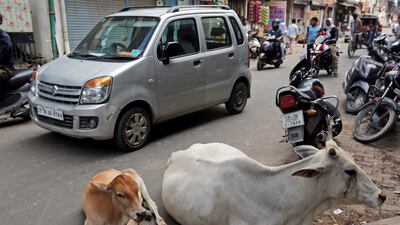India’s recent violence and political grandstanding over the sanctity of the cow mask an ugly truth: the animal is frequently mistreated, housed miserably, fed rubbish or left to fend for itself.
In one episode of violence after another, Hindu nationalists have attacked — even lynched — people suspected of eating, possessing or transporting beef.
Last week, a Muslim member of the ruling Bharatiya Janata Party in Maharashtra was beaten up by a group of eight men who thought he was in possession of beef.
The BJP, under prime minister Narendra Modi, has pushed the agenda of cow protection.
In its 2014 election manifesto, the party promised to protect “the cow and its progeny” in a nod to the party’s Hindu nationalist roots and in an attempt to appeal to India’s huge Hindu population, which holds cattle — particularly cows — to be sacred.
In June, Mr Modi’s government passed a law that blocked the sale of cattle for slaughter but it was suspended a month later by the supreme court, which said that the move unfairly affected the meat and leather industries. The government was asked to amend the law and submit it for judicial review.
Both BJP politicians and vigilante groups have protested that the act of eating beef, or of slaughtering cattle, hurts the sentiments of the Hindu population.
Yet, the mistreatment of cows has long been a widespread practice in India, said Naresh Kadyan, the India representative of the International Organisation for Animal Protection.
Mr Kadyan, who supports a ban on cow slaughter, has worked for the welfare and protection of animals for years.
He said that in 2000, he helped stop a train transporting cattle after learning that the cows were being injected with the hormone, oxytocin, to quicken lactation — an illegal practice in India.
The politicisation of cattle welfare has distracted from the real problem, he said, which is how India’s cows — some 283 million, according to a 2003 census — are treated.
While cows used to be prized for their economic value, they are now “unproductive, as they have been replaced by machines”, Mr Kadyan said, adding that cows had “become a tool of publicity and politics to divide society”
In states such as Haryana, Punjab, Rajasthan, Gujarat and Uttar Pradesh — where the consumption of beef is less common than in the south or north-east — cows are treated well until they are unable to provide milk.
“When they become unproductive, they are then kept in animal shelters that are like full-time jails,” he said. “There’s no scientific care for the rest of their lives. They have no exercise, no freedom of movement, and no land to graze on.”
In 2010, an investigation by the Indian chapter of People for the Ethical Treatment of Animals found rampant abuse of cows in the dairy industry.
It found that cows were frequently injected with oxytocin, although the hormone causes stomach cramps and pain, to boost milk yields.
“Most [cows] are chained by their necks in narrow stalls, where they are unable to stretch or move normally,” according to Peta. “Lack of proper food causes them to suffer from digestive problems, and lack of exercise causes lameness.”
Unproductive cows may also be turned out of their farms, resulting in the sight that is so familiar in Indian cities: the solitary cow, wandering the streets and picking plastic out of refuse bins.
At least half of the cows sold to slaughterhouses die before they even get to the abattoir because they are forced to walk there, according to Peta.
Yogi Adityanath, the new BJP chief minister of Uttar Pradesh, has promised to improve the conditions of cows in his state.
In May, his government announced a Cattle Healing Mobile Van Service — an ambulance for cows, which may be summoned by anyone who spots a cow in distress.
Echoing promises by Mr Modi’s central government, Mr Adityanath also proposes to establish “cow sanctuaries”.
Some of these shelters are to be housed on the premises of penitentiaries because, as one minister put it, jails have land and manpower to tend to the cattle.
However, Mr Kadyan thinks this is a bad idea.
“These shelters will function without any sort of scientific approach,” he said. “These are just so-called animal rights activists using the cow as a political tool — to misguide others to achieve their own political targets or for personal gain or profit.”

